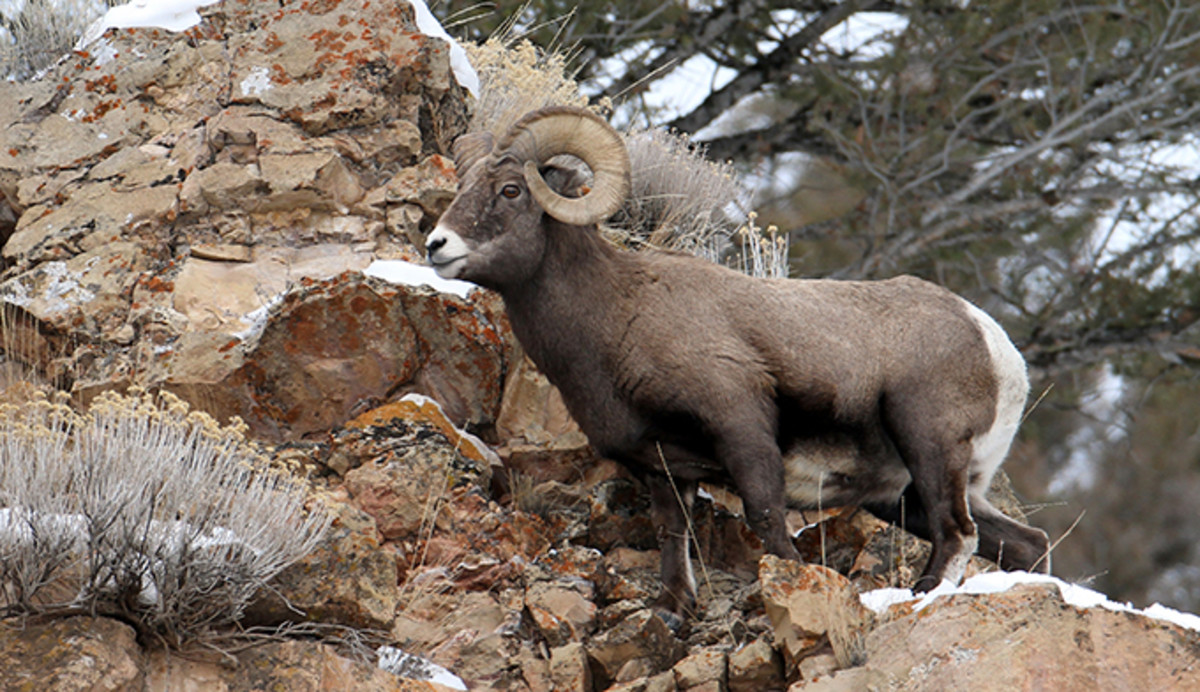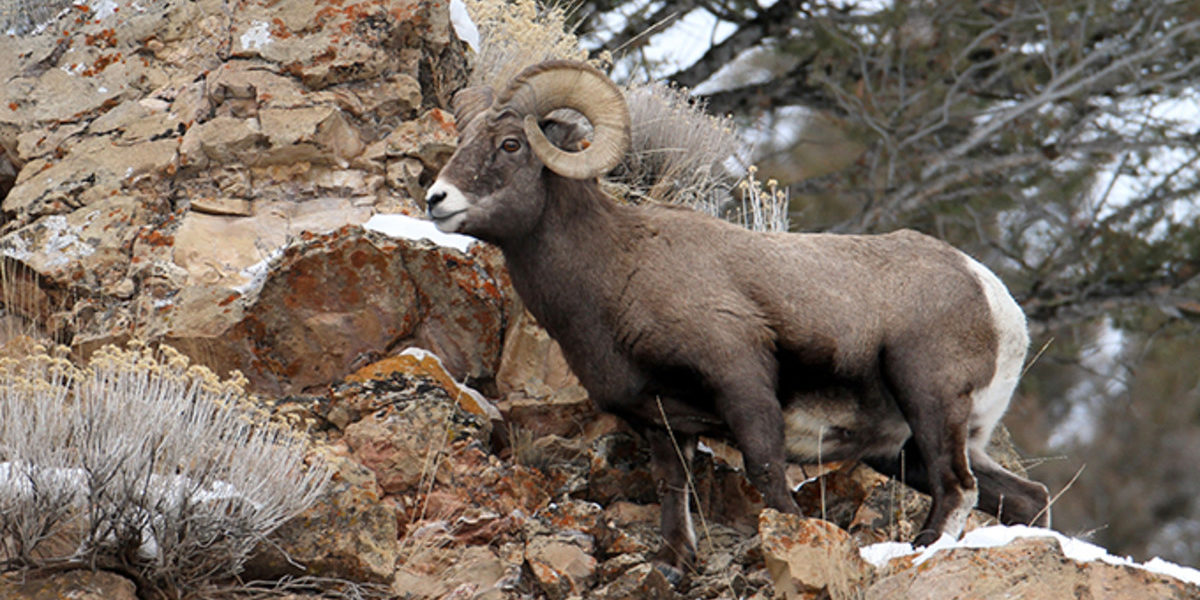
They wonder: Why increase tags while considering decreasing skiing to protect sheep?
By Billy Arnold
Jackson Hole News&Guide
Via- Wyoming News Exchange
JACKSON — This fall, a hunter successfully harvested one bighorn ram just west of Grand Teton National Park, after Wyoming wildlife managers increased the number of tags on the Tetons’ west slope from one to two.
But the increase in tags for the 2023 fall season — and one hunter’s successful pursuit — came as Grand Teton formally considers new protections for the Teton range’s bighorns. This spring, park officials are expected to release a draft environmental assessment outlining “alternatives” for protecting bighorn sheep, “alternatives” that will likely contemplate new closures of alpine terrain coveted by skiers and sheep.
The confluence of the increase in hunting tags and looming debate about new closures has some skiers wondering why the state increased hunting opportunity in the Targhee Herd, which dwells in the Tetons, at the same time land managers are mulling decreasing recreational access to protect the same herd.
“I think there is a disconnect,” said Kim Havell, a ski guide whose family also operates an outfitting business in Teton County, Pendergraft Outfitters. “It doesn’t make sense from an outside perspective that you’d increase tags while you’re asking other people to protect routes to protect the animals.
“But I also think there’s a reason why,” said Havell, who is a steering committee member for the Teton Backcountry Alliance, which advocates for human-powered recreation in the backcountry.
In the 1980s, the department issued seven tags for western Teton bighorn rams. But to protect the range’s herd, Game and Fish dropped the number of bighorn sheep licenses to four in the early 2000s, to two in 2008 and, eventually, to one in 2018 in part because winter population counts had fallen.
Then in 2023, Game and Fish bumped the tags back up to two.
Aly Courtemanch, Jackson area wildlife biologist for the Wyoming Game and Fish Department, said there are two primary reasons why. The first has to do with ecology and the second with how difficult bighorn hunting is on the Tetons’ rugged western slope. Only six of 15 hunters that Game and Fish has authorized to hunt in the area in the past 10 years have succeeded in harvesting a ram.
Ewes, which are female sheep, and lambs are the reproductive muscle of a sheep herd. Older rams, which are male, will typically mate with more than one female, meaning fewer rams are required for a herd’s survival than ewes. In 2021 and 2022, deer, sheep, goat and bear hunters reported more mature rams in the western Teton hunt area than usual. In 2019, winter counts of the entire herd also began to increase.
The science of sheep herds and the Teton herd’s increasing numbers gave Game and Fish confidence that issuing another ram tag wouldn’t hurt the population of roughly 178 animals, based on recent estimates.
Game and Fish also worried that having too many rams could hurt the herd.
“Bighorn sheep only need a small number of older males to accomplish the breeding,” Courtemanch said. “Especially in the Tetons, having a lot of extra males above and beyond that could actually be detrimental because we know there’s really limited resources in the winter time for that herd.”
Courtemanch also drew a distinction between how sheep act in the fall and winter — and how humans interact with them. Fall hunting happens when rams are separate from ewes and lambs, which limits the stress those ecologically critical herd members would feel during a hunting season.
In general, fall is also significantly less energetically intensive than winter, when sheep do everything they can to maintain fat to sustain themselves in colder months.
Skiers, meanwhile, can run into rams, ewes or lambs in alpine terrain during the most difficult time of year.
“The future of that herd is really driven by the ewes and the lambs, so protecting them in the winter, increasing their survival in the winter is really key for the survival of that herd,” she said.
Courtemanch acknowledged that the role hunters play in funding Game and Fish was considered when the department made its decision. Revenue from hunting and fishing licenses funds almost everything Game and Fish does, and the department wants to give hunters every opportunity they can, particularly when it can take decades to draw a bighorn license.
But the revenue from one extra ram license — $3,200 for a nonresident and $150 for a resident — isn’t a substantial sum for Game and Fish, which had a nearly $100 million budget in the past fiscal year.
Rather, the decision was about hunting opportunity, Courtemanch said.
“We shouldn’t be telling bighorn sheep hunters to sit and wait longer for no biological reason,” Courtemanch said. “If we feel like there is hunting opportunity that’s available, we want to be offering that to hunters who have been waiting a long time to draw these licenses.”
Before the Wyoming Game and Fish Commission approved the western Teton bighorn hunt last year, only one person wrote in to oppose the plans: retired wildlife biologist Deb Patla, who lives in Moran.
“There should not be any hunting at all of this struggling band of bighorn. Being hunted and shot at will increase the sheep’s wariness of humans and their fear,” Patla wrote.
The department’s “willingness to kill bighorn via hunting will discourage the long effort to get recreationists to respect area closures or disturbance,” Patla added.
One vocal critic of Game and Fish’s decision — and closures to protect sheep in general — pointed to a line from Michael Whitfield’s 1983 study of Teton range bighorns to question the tag increase.
“Man is not inherently an unpleasant stimulus to bighorn sheep. Bighorns from totally unhunted populations may habituate to people to the point of ignoring human presence, or even seeking it out,” Whitfield wrote in 1983. “However, if hunted to even a light degree, rams soon learn to avoid humans.”
Greg Collins, a backcountry skier and guide, looks at that line to argue that skiers themselves don’t disturb sheep. Rather, he argued that it’s hunting that “changes the behavior of sheep towards humans.”
Hunting could, consequently, be causing sheep to avoid territory that skiers frequent, Collins said.
Whitfield’s paper also cites other research from the ’70s that indicated that rams in Wyoming’s Whiskey Mountain Herd actively avoid people, “except during the rut and spring green up,” and that rams “abandon optimal summer and winter ranges to avoid human contacts” while ewes are less sensitive.”
“Passive human disturbance may prevent bighorn sheep from exploiting their entire habitat potential, may cause increased energy expenditures, and may lead to increased predation,” Whitfield wrote later in his study, citing research from 1976. “Activity patterns and distribution on occupied ranges may be altered, and parts of ranges abandoned by bighorn when human use of an area is high.”
Subsequent research, including Courtemanch’s, supports that assertion.
Katie Cheesbrough, a backcountry skier and executive director of the Wyoming Wild Sheep Foundation, said the main distinction between the hunt and backcountry skiing is that hunters are only targeting rams, and only a few hunters at a time are pursuing them in the fall, when they are separate from ewes and lambs.
“When you’re skiing, you might see ewes, you might see lambs,” Cheesbrough said. “That ewe might not be able to have the energy reserves to give birth or to support a lamb the coming spring.”
The distinction, in Cheesbrough’s mind, is that hunting is “highly regulated” while skiing is not.
“I’m not pushing for regulation of backcountry skiing,” Cheesbrough said. “But to close these small areas that are of the utmost importance to the sheep seems like, to me, a smaller sacrifice.”
Bighorn hunting regulations for the fall are proposed in the spring. While specifics have yet to be ironed out, Courtemanch expects the proposal for 2024 to be similar to last year. If people have feedback, or concerns, she encouraged them to submit public comments when draft regulations are published.





